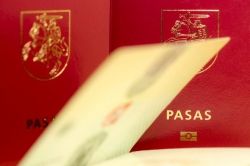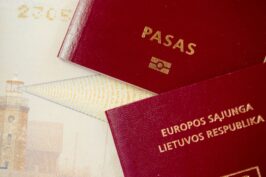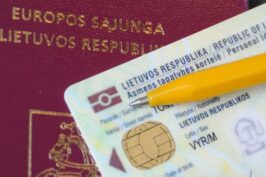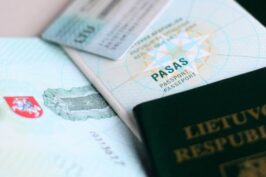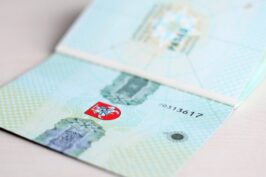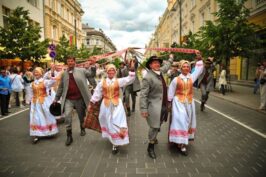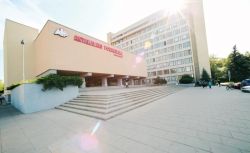- Home
- Jews in Lithuania during the interwar period and the right of Lithuanian Jews (Litvaks) to Lithuanian citizenship.
Jews in Lithuania during the interwar period and the right of Lithuanian Jews (Litvaks) to Lithuanian citizenship.
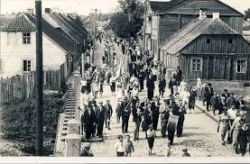

The independent Lithuanian state, re-established in 1918.
In 1919-1920, Polish and Soviet Russian troops occupied Vilnius several times in succession. Vilnius was repeatedly alternately occupied by Polish and Soviet Russian troops. In 1922, Vilnius was incorporated into Poland by military force. Over a short period between 1918 and 1922, during repeated changes of power – the Republic of Lithuania, Soviet Lithuania, the armies of Poland and Soviet Russia, the Jewish community again had to undergo significant economic hardship and national troubles.
The Lithuanian Jewish community, whose centre was the interim capital city of Kaunas, and its various representatives were actively involved in the establishment, strengthening and military defence of the Lithuanian state and in diplomatic activities aimed at its international recognition. More than 500 Jewish volunteers took part in the battles for Lithuanian independence.
The Constitution of the Republic of Lithuania of 1922 contained a provision declaring that all Lithuanian citizens were equal before the law. A special section “Rights of National Minorities” stated that to the extent prescribed by law, these minorities were autonomous in administering the affairs of their national culture, i.e. public education, charity, and mutual assistance. They elect their representative bodies to manage the affairs.
The years of 1919-1922 are marked in the historiography of Lithuanian Jews as the “golden” or “honeymoon period”. In addition to ministers, Jews had their representatives in the Sejm. The 1920 law granted the Jewish Kagals broad rights in administering spiritual religious affairs, charity, social aid, public education, and the keeping of civil status certificates.
Over a short time, Jewish organisations did a lot of work to improve the lives of thousands of Jews who had returned from Soviet Russia, to settle and provide them with work, to rebuild the devastated region, to establish a wide network of their schools, healthcare, charity, social assistance, and culture institutions.
Unfortunately, right-wing reactionary forces were strengthening in Lithuania at the time, and the liberal-democratic trend of development was weakening. The Jewish national autonomy recognized by the state, with all its organs, was gradually shrinking and was finally abolished. This also influenced the representation of Jews in the State Sejm, as well as the use of the Jewish language in state bodies. From 1924, the Minister for Jewish Affairs was no longer in government. The activities of the Jewish National Council were prohibited. In March 1926, the Jewish community kagals were abolished. The functions of civil registration were transferred to the rabbis.
After the signing of the peace treaty, about 100,000 Jews returned to Lithuania from Soviet Russia. According to the 1923 census, Lithuania (without the Klaipėda region) had 2.03 million inhabitants, including 1.7 million (84.2%) of Lithuanians and 153.7 thousand (7.6%) of Jews. As regards urban residents, 57.1% were Lithuanians, and 32% were Jews, while in rural areas, 23% of residents were Jews. In Ukmergė, they were 37%, in Panevėžys 36%, in Kaunas 27%, and in Šiauliai 25%. They lived in almost all townships.
The Jews managed to restore or re-build their homes. In many areas of trade, industry, and crafts the Jews proved to be an important force in terms of the development of new enterprises and workshops.
The unfolding of Jewish life in the environment of the Republic of Lithuania should be generally assessed positive. However, in the light of the specific historical process, it was still contradictory and dangerous tendencies had already appeared in it, the manifestations of which have initially obscured and later shook the fate of the Jews.
A military coup took place on 17 December 1926. An authoritarian-police regime was established and consolidated. Gradually, the democratic rights and freedoms, previously curtailed, were ultimately abolished. Even before the coup, in the first half of the twenties, when the Lithuanian state was consolidating, the Jewish national-cultural autonomy was liquidated in violation of international obligations and constitutional provisions.
Antisemitism became increasingly evident in Lithuania at the outbreak of the economic crisis in the late twenties and early thirties, and as Hitler came to power in neighbouring Germany in 1933. After a nine-year gap, there were no representatives of national minorities in the elected Sejms in 1936. The Constitution of 1938 no longer contained any provisions on them.
Jews became increasingly painfully aware of the uncertainty of the future under these unfavourable conditions. Concern arose about the prospects for Jewish youth in Lithuania. The only real solution was to emigrate. From 1920 to 1940, 102.5 thousand people, about 20% of them Jews, emigrated from Lithuania. Of 41.3 thousand who emigrated in 1928-1939, about 13.9 thousand (33.2% of all Lithuanian Jews) were forced to emigrate to Lithuania. Of 41,300 who emigrated in 1928-1939, 13,900 (33.6%) were Jews. In 1920-1940, 7,200 persons went to South Africa and 5,000 to Palestine, almost all of them Jewish. Jewish emigration in the 1930s could have been much greater, but it was held back by restrictions imposed by the US and some other countries, and by England’s policy of preventing Jews from moving to Palestine.
The emigration of Lithuanian Jews (Litvaks) began in the mid 19th century and continued until the late 1930s to the USA, Canada, Palestine, South America, South Africa, and Australia.
Litvaks in many places, including the US and Canada, were the first publishers, editors, and journalists of Jewish newspapers and magazines in Hebrew and Yiddish.
The first founders of the Jewish community in South Africa were Lithuanian Jews who arrived in the nineteenth century, and later a large part of the country’s Jews came from the province of Kovno. Lithuanian Jews also played an important and honourable role in the revival and expansion of the historical national hearth of Jews in Palestine.
Persons who emigrated from Lithuania commonly acquired citizenship of a foreign country, and their children, grandchildren, and great-grandchildren usually became citizens of that foreign country.
In order to maintain legal relations with Lithuanian emigrants, Lithuania provides for the institution of restoration of Lithuanian citizenship, which entitles a person who had Lithuanian citizenship before 15 June 1940 and who left Lithuania before 11 March 1990 to restore Lithuanian citizenship without giving up their existing citizenship (dual citizenship). This person’s descendants (children, grandchildren, great-grandchildren) can also benefit from the possibility to restore Lithuanian citizenship.
Under the Lithuanian Citizenship Law, persons who held Lithuanian citizenship before 15 June 1940 and their descendants who did not acquire Lithuanian citizenship before the entry into force of this Law shall have an indefinite right to restore their Lithuanian citizenship, regardless of the state in which they permanently reside.
Article 7 of the Lithuanian Citizenship Law provides for cases where Lithuanian citizenship may be restored without giving up the existing citizenship of a foreign state.
This article stipulates that a Lithuanian citizen may also be a citizen of another state if he or she is a person who left Lithuania before 11 March 1990 or is a descendant of such a person.
Considering the following provisions of the Lithuanian Citizenship Law, in order to restore Lithuanian citizenship without renouncing the citizenship held, the following key circumstances must be proven:
- Lithuanian citizenship until 15 June 1940;
- Departure from Lithuania by 11 March 1990;
- Other circumstances (kinship, change of name, surname, etc.)
MIGRATION LAW CENTER
